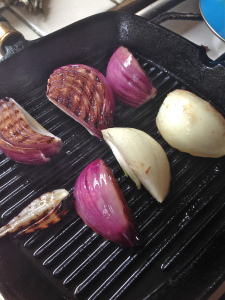I know I’m not the only one who has experienced the ‘bloated feeling’, when your tummy is stretched, puffy, uncomfortable and feels like a permanent rubber dingy round your waist. It often follows a big weekend of eating badly or late into the evening or some other festive occasion.
But for some people, bloating is more than an occasional inconvenience. If your stomach or tummy often feels bloated, it could be due to several things besides excessive wind and constipation.
Funny, I was always told as a child to chew my food properly and to drink peppermint tea and water, I wish I knew then what I know now that these are some of the aids to reducing bloating.
Medical advice is always advised if this appears to be your experience over a sustained period of time, but for many other people, there are moderate changes and intelligent ways we can incorporate ‘Bloat Beating’ foods into our diets and hopefully avoid the need for medical intervention.
This week I will be sharing with you 7 recipes that combine some of the many foods that help reduce bloating. Feel free to share your reviews and tips as I would gladly welcome them!
Breakfast:
Warm lemon or lime water is not only a good defence against the common cold, it also serves as the perfect ‘good morning drink’, to flush out toxins and kick start your digestive system. Lemon water also prevents constipation and diarrhea, by ensuring smooth bowel functions.
Lemon is also a rich source of vitamin C, which enhances your beauty by rejuvenating skin from within bringing a glow to your face, and helping to prevent the formation of wrinkles and acne.
One of the major health benefits of drinking lemon water is that it paves the way for losing weight faster, thus acting as a great weight loss remedy. So before anything else enters your system, have a tall glass of lemon/lime water every day.
All kinds of melons are beneficial to your health, but watermelon is known as one of the juiciest fruits on the stand. That’s probably because it consists of 92 percent water. It is also reported to have a natural diuretic property and is a great source of potassium.
Too high an intake of salt is one of the most common causes of water retention around the abdominal area. Foods rich in potassium, such as bananas, help combat bloating caused by salty food. When incorporating bananas into your anti-bloating diet, be sure to only eat ripe fruit — unripe bananas contain resistant starch which can cause wind and bloating.
Try the Watermelon ‘Brain Freeze’ Smoothie on the blog for a potassium rich start to the day!
Cultured natural yoghurt typically contains Lactobacillus acidophilus and/or Bifidobacterium bifidum (or ‘friendly bacteria’ as it’s otherwise known ). This probiotic bacteria lives in the gastrointestinal tract where they help digestion and fight the overgrowth of harmful bacteria, thereby preventing bloating. You can actually purchase Probiotic Acidophilus in a tablet form from good health shops or online; but a tasty package to enjoy this is Greek Yoghurt with Honey.
Fiber helps relieve constipation, which is an all-too frequent cause of bloating. By adding bulk in the form of certain cold or hot cereals, everything moves through the intestines more quickly. Just be certain to not add too much fiber to your diet too fast, or worsened bloating can occur.
- Strawberries and Blueberries
Fiber also takes the form of certain delicious fruits and berries. Snacking on high-fiber foods such as strawberries and blueberries, can help clean out one’s system regularly.
Why not try the Peanut Flax Granola recipe on the blog with some of the Greek Yoghurt and berries for a perfect bloat busting breakfast!
Lunch:
Some foods, especially certain carbohydrates, are either indigestible or only partially digested in the gut. These foods can cause gas buildup and therefore bloating. Rice however, particularly brown rice makes a good substitute for starches such potatoes. Rice is fully digested in the small intestines, giving it the least potential to form gases in the gut.
You’re probably familiar with turmeric as the main spice in curry. It has a warm, bitter taste and is frequently used to flavor or color curry powders. But the root of turmeric is also used widely to make medicine. Turmeric is used for many ailments including to treat, intestinal gas, stomach bloating, heartburn and liver problems.
This week on the blog: A quick Pilau Rice recipe which combines these ingredients for an easy tasty way to a flatter stomach!
Rosemary has been used to treat everything from heartburn and headaches to toothaches and high blood pressure. But it also treats intestinal gas and helps digestion. Garlic helps reduce the levels of fat in the liver, whose main functions include detoxification and the production of biochemicals necessary for digestion — major aspects of the prevention of bloating.
Try the garlic and rosemary infused sweet potato chips, the crispiest chips every time!
Dinner:
Celery:
Over the years this green crunchy stalk has been used as a digestive aid to regulate bowel movements and to control intestinal gas because its chemicals are known to decrease fluid retention. Because of its high water content with a detoxing system, this helps purge your body of toxins.
Check out this tasty celery recipe on the blog this week!
Beans and Lentils:
Most of us grew up believing beans was the source of all bloating and flatulence, but don’t be too harsh on the little gems, their high amount of fiber, are a good choice for aiding with digestion. The potassium-rich foods are also naturally high in both estrogen and protein and can relieve period-induced bloat.
Kale and Spinach
These green leaves, in addition to lettuce and chard, require ample chewing and provide a healthy dose of fiber, vitamins, and minerals. They also help with acid indigestion, constipation, and urinary tract infections.
Another healthy recipe combining these ingredients will be coming your way this week…
Like this:
Like Loading...





